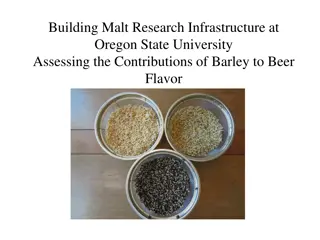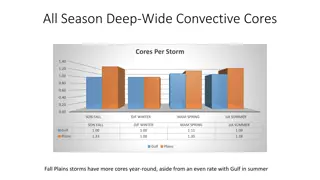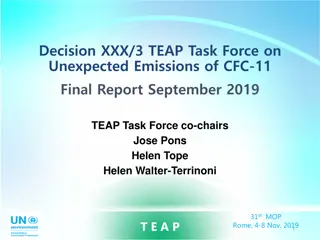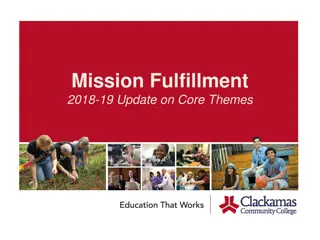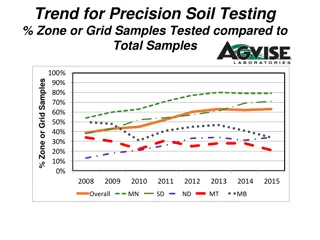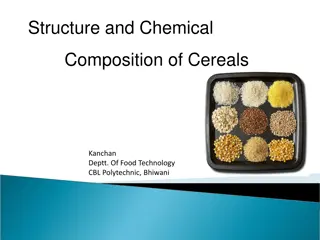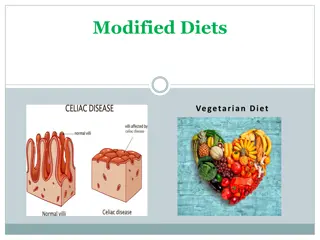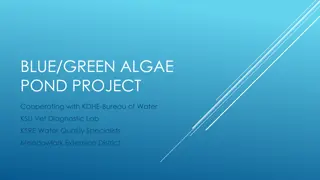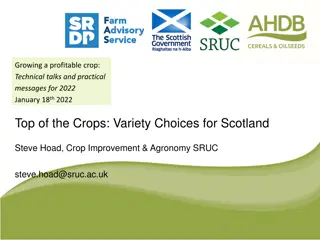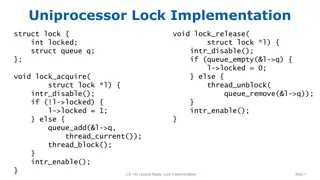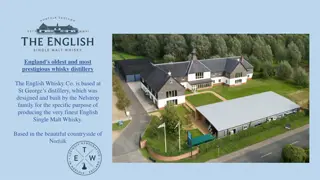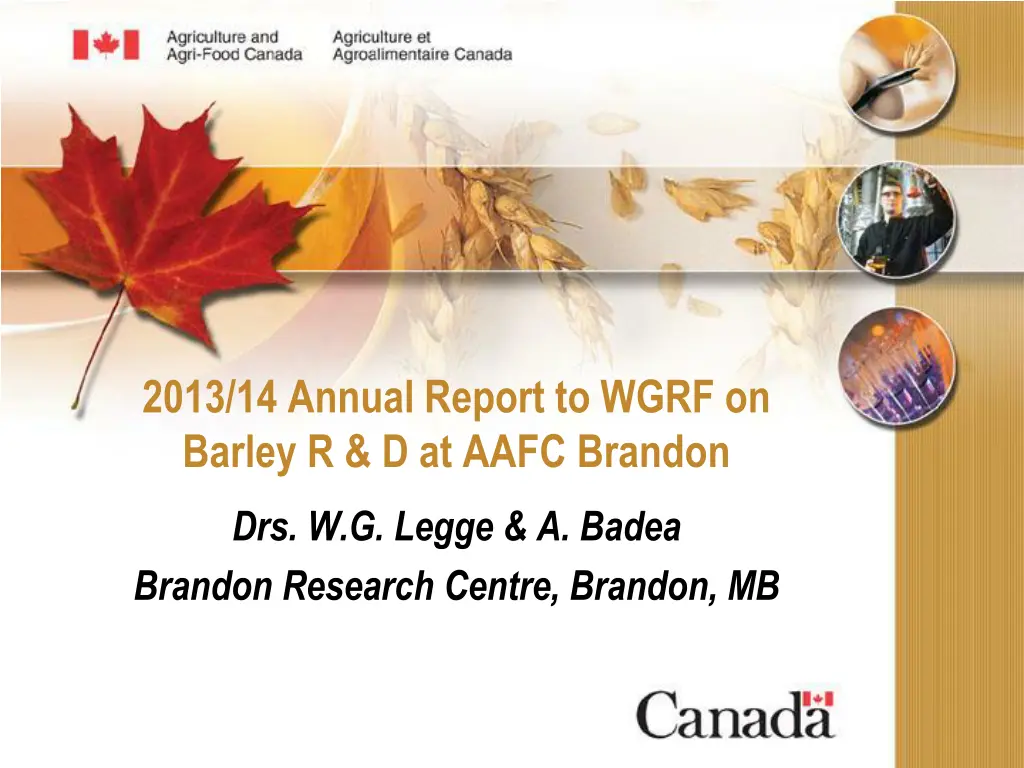
Barley R&D Annual Report 2013-14: Cultivar Status & Varieties Overview
Explore the comprehensive 2013-14 annual report on barley research and development at AAFC Brandon Research Centre, highlighting the status of two-row malting cultivars like Legge, AAC Synergy, TR10214, and second-year coop and first-year collab entries. Discover key insights on yield, disease resistance, malting quality, and more. Stay informed about the evolving landscape of barley cultivation in western Canada.
Download Presentation

Please find below an Image/Link to download the presentation.
The content on the website is provided AS IS for your information and personal use only. It may not be sold, licensed, or shared on other websites without obtaining consent from the author. If you encounter any issues during the download, it is possible that the publisher has removed the file from their server.
You are allowed to download the files provided on this website for personal or commercial use, subject to the condition that they are used lawfully. All files are the property of their respective owners.
The content on the website is provided AS IS for your information and personal use only. It may not be sold, licensed, or shared on other websites without obtaining consent from the author.
E N D
Presentation Transcript
2013/14 Annual Report to WGRF on Barley R & D at AAFC Brandon Drs. W.G. Legge & A. Badea Brandon Research Centre, Brandon, MB
Status of Two-row Malting Cultivars - Legge AC Metcalfe still the most widely grown variety in western Canada in 2013, but starting to decline. Newdale increased slightly to 8% of 2013 acreage. niche malting variety used by Canada Malting. Norman - joint with CDC / U. of Sask. FP Genetics will drop it due to lack of interest from industry. Major - released to Viterra; occupied 3% of 2013 acreage. added to the 2013-14 recommended malting barley varieties list (CMBTC). Cerveza still undergoing seed increase and market development by Mastin Seeds. 2
Status of Two-row Malting Cultivars - Legge: AAC Synergy (TR09208) registered and released to Syngenta in 2012. 13% higher yielding than AC Metcalfe over 2 years; shorter, stronger straw; heavier, plumper kernels; similar maturity. Desirable malting quality profile with higher malt extract and consistently lower beta glucan and wort viscosity, plus 0.5% lower protein content than AC Metcalfe. More resistant to spot and net blotch than AC Metcalfe, more susceptible to FHB and the smuts, and similar for other diseases. Close to meeting 5-year target, except for FHB resistance and some other diseases. 3
Status of Two-row Malting Cultivars - Legge: TR10214 supported for registration recommendation by PRCOB in February 2013, but no proposals were received then. Proposal was received from La Coop Federee in 2014; licencing agreement being developed. Consistently lower DON levels; 35% lower than AC Metcalfe over 14 site-years in Manitoba FHB nurseries. 10% higher yielding than AC Metcalfe over 2 years; slightly later; taller but stronger strawed; heavier, plumper kernels. More resistant to spot and net blotch than AC Metcalfe; more susceptible to common root rot and the smuts; and similar for other diseases. Acceptable malting quality similar to the checks. Entered in the western provincial regional trials in 2013. 4
Status of Two-row Malting Coop Entries: 2ndYear Coop and 1stYear Collab Entry in 2013 TR12225 will be advanced to 2nd year in 2014 Collabs. 11% higher yielding than AC Metcalfe over 2 years; shorter, stronger strawed; similar heading and maturity; heavier, plumper kernels, but lower test weight. Somewhat lower DON levels than AC Metcalfe, but not as low as TR10214 (has same resistance source as TR10214). Improved spot and net blotch resistance over AC Metcalfe; similar for other diseases; but poorer for loose smut. Promising malting quality profile with higher malt extract and friability than the checks: lower wort viscosity beta glucan content within the lower range of the checks AA and DP approaching AC Metcalfe generally similar to checks for remaining malting traits, with tendency for slightly lower FAN. 5
Status of Two-row Malting Coop Entries: 1stYear Entries in 2013 TR13231, TR13232, TR13233, TR13235 & TR12236 - all dropped, except for TR13232 and TR13235. TR13232 advanced to 2nd yr. Coop & 1st yr. Collab entry 8% higher yield than AC Metcalfe; good disease resistance including lower DON levels; and very promising malting quality profile. TR13235 advanced to 2nd yr. Coop & 1st yr. Collab entry may have low proanthocyanidin content to reduce chill haze in beer (TR05290 one of its parents) combined with better malting quality. 6% higher yield than AC Metcalfe with higher DON levels. 6
Status of Two-row Malting Coop Entries: 1stYear Entries in 2014 TR14237, TR14238, TR14239, TR14240 and TR14241 - all combine good agronomic performance with acceptable malting quality & good disease. TR14237, TR14240 & TR14241 may have lower DON. 7
Status of Two-row Feed Lines: 1stYear Entries in 2013 - TR13234 TR13234 failed malting barley line from Dr. Legge s program. 13% higher yielding than AC Metcalfe but 2% lower than the feed check Xena. Good disease resistance package, particularly to spot blotch and both forms of net blotch. Lower DON content than AC Metcalfe, similar to Xena, but higher than CDC Mindon (target for two-row barley). Did not show sufficient advantage and was dropped. 1stYear Entries in 2014 None. No lines remaining from Dr. Therrien s program are expected to meet the feed objectives. 8
Status of Two-row Hulless Malting Lines Taylor (HB705) Improvement in two-row hulless malting quality. Lower DON levels than CDC Freedom. Close to meeting disease objectives, but spot blotch and common root rot could be improved. Does not meet yield target for 5-year objectives. Alliance Seed Corporation is handling market development and distribution of Taylor; is looking at food potential first. 1stYear Entries in 2013 none. 1stYear Entries in 2014 none until at least 2015. 9
Status of Food Cultivars Badea/Therrien: Millhouse - Two-row hulless food barley (flour type): License for Millhouse held by FP Genetics was terminated, by mutual consent, in April 2010. Will be deregistered in due course. Roseland(HB122) - Two-row hulless food barley (flour type): Registered in 2011. In spring 2014, Wayfinder Farms obtained a non-exclusive licence for it. SEMICAN evaluated it under Qu bec conditions in 2013 and will evaluate at higher number of sites in 2014; if successful the company may also request a licence for it. 10
Status of Forage / Feed Cultivars Badea/Therrien: Binscarth - Six-row silage and grazing barley: License for Binscarth was held by Wagon Wheel Seed Corp. Commercial production was ceased in 2009. Will be deregistered in due course. Desperado(FB012) - Six-row forage / feed barley: Registered in 2008 with distribution rights awarded to Alliance Seed Corporation operating as sub-licensee to Pickseed. About 2,497 acres of production reported in 2013 over 25 farms. Early sales reports indicated similar sales potential for 2014. There iscurrently still one pedigree seed grower. 11
Status of Six-Row Malting Advanced Lines Badea/Therrien: WCoop Entries in 2013 No new lines were entered in the 2013 test due to lack of significant yield increase and high -glucan content. 1st Year WCoop Entries in 2014 One new line, SR14316, was entered in the 2014 test. It has lower yield then CDC Mayfair but equal to Celebration, and an acceptable malting quality package and disease reactions similar to the checks except for DON content that is higher. If it continues to perform well, this new breeding line will comply with most of the proposed objectives; however, it will not meet the ambitious target of lower DON content than Quest. It is very difficult to combine in one line good resistance to FHB and a good malting quality profile. 12
Status of Six-Row Feed Advanced Lines Badea/Therrien: 1st Year WCoop Entries in 2014 Two new lines, SR14317 and SR14318, were entered in the 2014 test. SR14317 - ranked number one based on yield (120% over AC Metcalfe), was stable across the five locations, and showed a good disease package: MR to spot blotch & CRR, MRMS to net blotch, slightly lower DON content then AC Metcalfe, R to stem rust & smut. It seems to have very good palatability based on deer test ; thus was entered as FB019 in 2014 FBCoop test. SR14318 - has lower lodging, plumper grains, higher protein and kernel weight than both checks. Also has lower DON content than AC Ranger. It yields similar to AC Ranger but higher than Desperado. Class phasing out of the program. 13
Status of Hulless Food Advanced Lines Badea/Therrien: 3rd Year HBCoop Entry in 2013 - HB127: Flour producing two-row hulless food barley for the blended flour market. No additional agronomic and quality data could be collected during 2013 due to a mixture of the seed. The line was not put forward for registration in 2014. A selection has been made in this line, and it will be grown in the advanced replicated trial in 2014. 14
Status of Hulless Food Advanced Lines Badea/Therrien: 2nd Year HBCoop Entries in 2013: HB129 ( waxy type food barley) and HB130 (flour producing barley) were not put forward for registration recommendation. The waxy line HB129 did not show sufficient merit over the checks, For the milling line HB130, the quality data was not received in time. Further investigation and consultation with industry is planned. If warranted, it may be proposed for registration recommendation in 2015. During 2014, HB130 will be grown in the Quebec screening trial. HBCoop Entries in 2013: No new lines were entered in the 2013 test due to the 2011 flood which set back the program one year. 15
Status of Hulless Food Advanced Lines Badea/Therrien: 1st Year HBCoop Entries in 2014: - Two waxy lines, HB132 and HB133 were advanced to the 2014 HBCOOP test. - Although not conforming to the specifics of the objectives, they have shown 5 to 6% yield increases over the waxy check variety, CDC Rattan. 16
Status of Hulless Feed Advanced Lines Badea/Therrien: This effort has been discontinued. There are no lines left for evaluation from this effort. 17
Status of Forage Advanced Lines Badea/Therrien: 1st Year FBCoop Entries in 2013 FB018: was dropped from further testing because it did not show improvements over the checks. 1st Year FBCoop Entries in 2014 FB019: was also entered as SR14317 in 2014 WCoop test See above for details. 18
WGRF Barley Check-off Funds to AAFC Brandon W. Legge (%) A. Badea / M. Therrien (%) Allocation by Barley Class (% in red italics for new Barley Cluster) Two-row Malting 51 (80) Six-row Malting 18 (40) Two-row Feed 0 (20) 7 (0) Hulless Food 18 (40) Forage 6 (20) 19
FHB Project (W. Legge, Project Leader): Conducted 5th year of revised FHB project Adequate funding in 2013. Core Brandon FHB Nursery consisted of 8,640 rows in 2013 for advanced breeding lines from all programs; registration trials, variety, NABSEN and other critical material; & 500 rows of wheat for Portage exchange 8,455 rows harvested & processed. Warm, moist conditions during the summer resulted in very high DON levels. 20
FHB Project (continued): FHB nurseries at Ottawa, Charlottetown and Portage grew 500 rows of elite material all harvested and sent to ECORC for DON testing by ELISA. additional 260 rows for registration tests at Portage (total of 760 rows, down from the usual 1,000 rows due to labour constraints at the CRC), but site had high DON levels. DON levels at Charlottetown high but less extreme than normal. DON levels at Ottawa were moderate. Discontinued visual ratings of symptoms for most advanced breeding lines in favour of pre-screening step for DON using NIRS at both CDC and FCDC. 2,250 samples sent to CDC and 1,432 to FCDC lab. No lines from BRC breeding programs were sent to NIR labs. 21
FHB Project (continued): Continued DON testing by ELISA at ECORC All 5,984 samples were done in a timely manner. Conducted about 2,850 visual ratings on critical material, including the 500 wheat lines. DON testing at Laboratory Services, University of Guelph, reduced pressure 1,360 samples done with Neogen Veratox for DON 5/5 kit. Provided fast service and accurate results. Good agreement among methods, and more positive response in the ability of NIR to predict DON content than over the last two years Due to higher DON levels in 2013? 22
FHB Project (continued): Outside core Brandon FHB Nursery, 5,246 rows were grown for populations segregating for FHB resistance from Dr. Legge s program and 422 used for a genetic study in collaboration with Dr. Brian Steffenson, University of Minnesota. Not part of the formal FHB project. All rows for genetic study were rated visually, harvested, and sent to the University of Minnesota for DON analysis. Visual selection based on FHB symptoms and agronomic performance was used to select 1,297 lines from segregating ;populations; no DON analyses were done due to lodging. 2,880 rows of former capacity not used. 23
Funding for FHB Project Budgets from 2013-14: 2014-15 FUNDING AGENCY 2013-14* 2015-16 2016-17 2017-18 ADF via CDC $64,800 $64,800 $64,800 ACIDF via FCDC** $200,000 $200,000 $200,000 $200,000 $200,000 WGRF Barley Cluster $30,666 $31,645 $32,623 $33,602 $34,584 BMBRI Barley Cluster $10,000 $10,000 $10,000 $10,000 $10,000 AAFC Barley Cluster $100,073 $100,074 $100,074 $100,074 $100,074 TOTAL $405,539 $406,519 $407,497 $343,676 $344,658 For 2013-14 & beyond: *All funds are gross totals with no overhead or other costs removed. **ACIDF funding ended on March 31, 2014, and replaced by the new Beef Cluster. Funding in red is from the new Barley Cluster. 24
Personnel Changes Recent changes to Dr. Legge s staff: Senior Technician Bev McLeod retired in September 2012 Process started, but position not filled yet. Recent changes to Dr. Badea s staff: EG-05 Molecular Genetics Research Assistant position for the Cereal Breeders Molecular Lab was filled by Shunzhen Zhang in summer of 2014 and she is reporting to Dr. Badea. 25
Resource Constraints Impacting Objectives: Dr. Badea s program acquisitioned in spring 2014 new: Plot Seeder from Fabro Enterprises Ltd. Wintersteiger Classic Plot Combine SLN3 Seed Cleaner Replacing old equipment that the program had. Dr. Badea is working towards the establishment of a molecular lab for all BRC cereal breeders: New equipment was purchased in spring of 2014, i.e. QIAxcel, QIARotor, Epmotion, etc. Dr. Badea and Dr. McLaren requested a MiSeq which was also acquisitioned in spring of 2014. However, there is still a need of powerful computers in the lab. Without these computers the data that will be generated cannot be processed. 26
Resource Constraints Impacting Objectives: New auto analyzer in the CRC malt lab purchased through the Barley DIAP was used to measure alpha amylase (AA) and diastatic power (DP) for all tests. Beta glucan was determined on all advanced malting samples from 2013. Constraints on hiring general labour or technicians continues to limit screening with the NIR and RVA at Brandon Protein content was not determined using NIR on potential entries for F5 F6 progeny rows from 2013. 27
Emerging Issues / New Research New initiative under the new Barley Cluster would be to incorporate stress tolerance, such as water-logging tolerance, into barley germplasm Dr. Badea obtained barley lines from Australia with water-logging tolerance, and would like to use molecular markers and doubled haploidy to hasten the process. In spring of 2014, greenhouse screening was performed on those lines from Australia with water-logging tolerance and some Canadian lines. Due to flooding, no field evaluation was performed in the 2014 growing season. This could set back the project one year. Field screening of these lines along with more recently acquired Japanese lines with water-logging tolerance is planned for 2015. 28
Emerging Issues / New Research Six-row malting Access to the Anheuser-Busch (AB) InBev six-row malting germplasm was lost due to the fact that their program switched to two-row malting. BMBRI is no longer going to run the six-row malting collaborative trails and it will be the six-row malting barley breeder s duty to run the trail. Almost all of Canada s six-row malting barley exports go to the USA, especially to AB and Miller. Access to overseas markets such as China has not been secured for Canadian six-row malting. Depends entirely on where AB and Miller go. Budweiser used to be 80% six-row in the malt blend, but considerably lower than that now. In some markets, Bud is made from 100% two-row. Miller remains at a high level of six-row in their blends. The remnants of Dr. Harvey s program from CDC were transferred in spring of 2014 to Dr. Badea s program. 29
Emerging Issues / New Research Monitor stripe rust situation. More entries to be sent through FCDC for evaluation in Washington stripe nurseries. Stem rust race TTKSK QCCJ resistance of Q21861 only partially effective against it. Work to be expanded in both breeding programs under new Barley Cluster. Reduced phytate in malting barley Evaluated 9 lines with reduced phytate content from crosses involving TR10218 in a replicated Preliminary Yield Test; 4 lines to be advanced to an Advanced Yield Test in 2014. 86 selections from 3 segregating populations for reduced phytate content to enter yield tests in 2014. 30
Emerging Issues / New Research Combining pre-harvest sprouting (PHS) resistance with superior malting quality Use the RVA where possible to screen for this trait. 134 lines with potential PHS resistance in yield testing system; could start entering coop tests in 2015. Ethanol assay for determining germination loss potential Project completed in 2011-12 with results to be written up by Dr. Wayne Buckley who has now retired. 31
Emerging Issues / New Research NIRS unit on-site (Unity Scientific SpectraStar 2500) will allow for rapid screening of malt, food, feed and forage quality. Ability to screen for forage quality operational. Screening capabilities for food quality operational. Screening for DON mycotoxin initiated; progress slow. Malting quality screening mainly conducted on Foss unit in Winnipeg owing to the proximity to the malting unit. CRC quality lab to remain in Winnipeg, and has been moved to a new location that requires considerable renovation in 2014; may affect availability of the lab to analyze samples in the fall. F5 F6 malting lines could not be screened for low protein with the NIR at Brandon in 2011, 2012 or 2013. Calibration for grain protein content needs some work. 32
Emerging Issues / New Research Budget details were finalized for the following 6 activities led Drs. Legge and Badea for 5 years under the new Barley Cluster being led by Alberta Barley with funding from the WGRF: Activity 2 Breeding Two-row Malting Cultivars (Dr. Legge) Activity 3 Breeding Two-row Feed Barley Cultivars (Dr. Legge) Activity 4 - Breeding Six-row Malting Cultivars (Dr. Badea) Activity 5 - Breeding Hulless Food Barley Cultivars (Dr. Badea) Activity 6 Breeding Forage Barley Cultivars (Dr. Badea) Activity 7 Developing FHB Resistant Barley Germplasm (Dr. Legge) Funding from BMBRI as well for Activities 2 & 7. 33
Emerging Issues / New Research - Flood 2014 Flood had 2 late peaks similar to 2011 levels which caused significant damage to both breeding programs as there insufficient warning to make other plans. Dr. Legge s program lost: All yield tests at Brandon, but may have coop entries in 2015. F1 to F4 bulk populations; miscellaneous increases; & short breeder rows for TR13232 & TR13235. 21 F5 populations in Leaf Disease Nursery; limited data for other tests. 40% of FHB Nursery; rest saved by temporary dike, otherwise would have been a complete loss; coops, variety test, NABSEN, Dr. Badea s test, FCDC test, some CDC material, BARI test, some eastern material, resistance sources test, some of Dr. Legge s F6 progeny rows, & 1 F5 population were flooded. 34
Emerging Issues / New Research - Flood Dr. Legge s program lost (continued): 25% of F5 and F6 progeny rows. Most of increases for Eastern Prairie Barley Test & Advanced Yield Test A. QCCJ Stem Rust Nursery survived, but few symptoms to date. Hamiota planted very late, moisture stressed, thin, but may obtain useable data. Bottom line is that the flood will put Dr. Legge s program about one year behind even with use of NZ winter nursery to regenerate or replace most of the lost material. May have no coop entries in 2016. 35
Emerging Issues / New Research - Flood Effect on Dr. Badea s program: Lost 3 of 5 Adv. Tests. Although the other 2 tests lost only 1 rep, the quality of the data that will be collected is questionable. Despite this, may have coop entries in 2015. Lost 2 of 7 Prelim. Tests. The other 5 tests have also been affected by losing either 1 or 2 reps. Some of those tests were grown at Hamiota. However, the data might not be sufficient for the advancement of the lines which will set back the program one year. May have no coop entries in 2016. Lost F5 and F6populations from Dr. Harvey s program. Lost of the F4 head rows. For those lost, seeds will still be available. Before the first crest of the river, more than 800 plants were transplanted to pots. 36
Emerging Issues / New Research - Flood Effect on Dr. Badea s program (continued): Lost test in FHB Nursery. Other tests were lost such as: oil test, FHB test, stem rust test, large increases, germplasm increase, etc. Water-logging field test not planted. Hamiota planted very late, moisture stressed, thin, but may obtain useable data. Most probably the flood will set back Dr. Badea s program one year. 37








